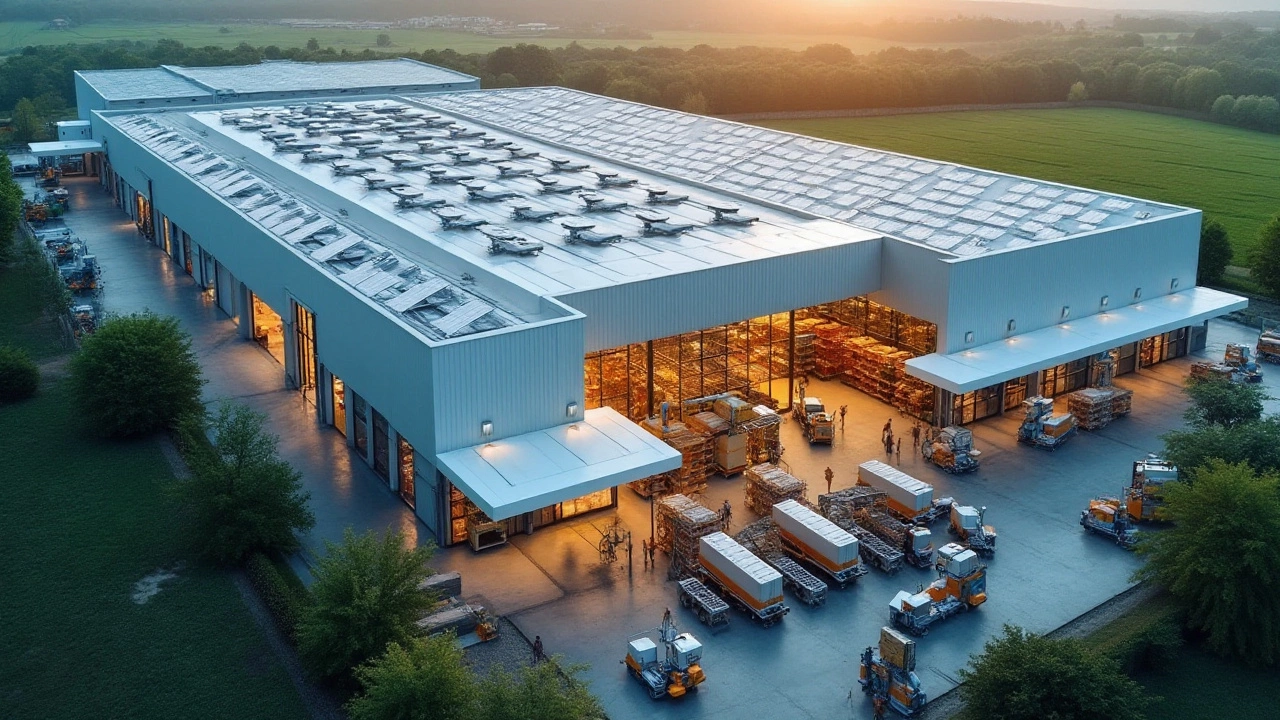As the world of commerce continues to evolve rapidly, so does the need for efficient storage and distribution. In this bustling environment, Warehouse Management Systems (WMS) have emerged as a pivotal tool. These systems are designed to address the complex dynamics of organizing and controlling warehouses, ensuring a seamless flow from inventory receipt to shipping.
Not limited to a particular type of business, WMS is finding its place in various sectors, helping companies keep pace with rising consumer demands. By using sophisticated technology, they bridge the gap between traditional logistics and modern supply chain requirements. Join us as we delve into who exactly benefits from the implementation of a WMS and the value it adds to their operations.
- Understanding Warehouse Management Systems
- Industries Utilizing WMS
- Benefits of WMS Adoption
- Future Trends in Warehouse Management
Understanding Warehouse Management Systems
In today's rapidly changing business landscape, a Warehouse Management System (WMS) has become a cornerstone for organizations aiming to streamline their inventory and logistics processes. But what exactly is a WMS? At its core, a WMS is a software application designed to support and optimize warehouse functionality and distribution center management. These systems facilitate the management of daily operations by tracking inventory levels, orders, and deliveries, thereby enhancing the capabilities of post-sale logistics. Often, it works hand in hand with other systems like transportation management systems (TMS) and inventory management software to create a cohesive technology ecosystem for a business. What sets a robust WMS apart is its ability to provide real-time insights, which is increasingly critical for responding quickly to market demands and ensuring customer satisfaction.
A good WMS should offer a range of features tailored to the specific needs of the business it serves. Key among these is the ability to receive and manage stock in multiple forms—whether that's individual items, pallets, or cartons. The system can then help sort this inventory, placing it into specified locations within a warehouse. Sophisticated WMS can even optimize and suggest the best storage locations based on frequency of access or storage requirements. This not only maximizes space utilization but also facilitates quicker retrieval when fulfilling orders. Furthermore, the integration of barcode scanning or RFID technology allows for accurate tracking of stock, reducing the risk of human error and loss.
Another critical advantage of a WMS is its role in enhancing employee productivity within warehouses. With efficient task management features, a WMS can assign jobs such as picking, packing, and shipping to warehouse staff based on real-time data, optimizing labor usage. Through user-friendly interfaces, employees can receive tasks on handheld devices or computers, ensuring clarity in roles and responsibilities. This minimizes idle time and ensures that the entire process—from order receipt to dispatch—is executed seamlessly. Thus, a WMS isn't just a tool for managing goods, but a comprehensive solution for optimizing the entire supply chain.
Interestingly, the origins of WMS date back several decades, with initial versions focusing on basic stock control. However, as noted by logistics expert James A. Cooke, "The evolution of warehouse management systems reflects the transformative impact of technology on supply chain operations." Since those early days, WMS technology has rapidly evolved to incorporate artificial intelligence and machine learning, which further refine warehouse operations by anticipating demand and adjusting stocking levels accordingly. The advent of cloud-based solutions has also made WMS more accessible to businesses of all sizes, breaking down the barriers traditionally associated with technology adoption.
With an increasing emphasis on sustainability, modern WMS are also adapting to meet the environmental expectations of today's consumer. Systems now offer features that help reduce waste and energy consumption, aligning with green practices. For example, a WMS might prioritize the picking of products with the nearest expiration dates first, or bundle shipments for more efficient transportation. These eco-friendly initiatives not only reduce costs but also enhance brand reputation in the marketplace.
Comparatively, smaller businesses benefit from tailored WMS solutions that cater specifically to their needs, providing scale-appropriate features without the overwhelming complexity suited for large-scale operations. On the other hand, large enterprises rely on advanced WMS capabilities to manage global supply chains, supporting multiple warehouses across different locations. It's the adaptability of a WMS, combined with its potential for real-time updates and extensive reporting, that makes it an invaluable asset for any organization serious about maintaining a competitive edge in the field.

Industries Utilizing WMS
When it comes to enhancing operational efficiency, a Warehouse Management System (WMS) is becoming indispensable across a variety of industries. For many in the retail sector, the demands of maintaining accurate, real-time inventory in both physical and online stores can be overwhelming without the structured approach a WMS provides. By tracking stock movements meticulously, retailers can ensure they never miss a sale opportunity due to lack of stock or suffer surplus losses. Retail giants use WMS not just for managing stock but also for gaining insights into buying patterns, thereby tailoring their supply chains to be more responsive to consumer behavior.
Manufacturers, especially those dealing with large volumes and complex supply chains, view WMS as a necessity rather than a luxury. In these industries, precision is key. With strict timelines to meet global demand, any disruption in material handling can affect the entire production line. Adoption of WMS allows manufacturers to track parts and materials seamlessly, ensuring that production schedules are adhered to and efficiency benchmarks are met. As a reflection of its utility,
Gartner, a leading global research and advisory company, noted that "a well-integrated WMS can reduce manufacturing costs by up to 20% by optimizing stock levels and streamlining operations."
The logistics and supply chain sector has also seen transformative changes with the advent of Warehouse Management Systems. Companies in this sphere operate under pressure to move goods quickly and accurately, making WMS a crucial tool. By using these systems, businesses can enhance their fleet efficiency, reduce delivery times, and provide real-time tracking information to clients. This transparency fosters trust and reliability, crucial elements in logistics services. Enhancing logistics through effective WMS is not merely about moving goods, but doing so with added value, improving the Bottom line for clients and businesses alike. It is clear that from retail shelves to manufacturers' plants, and freight carriers, the need for efficient warehouse solutions is making WMS a universal tool.
In the e-commerce industry, where speed is of the essence, WMS has become a game-changer. The pressure for next-day delivery or even same-day service means there is little room for errors in the supply chain. WMS assists e-commerce companies by automating manual processes, reducing human error, and optimizing storage systems. This translates to faster order processing times and more satisfied customers. The demand for immediate fulfillment in this digital age necessitates systems that can handle the pace—WMS fits the bill perfectly. According to a recent survey, companies reported up to a 40% increase in order processing accuracy after implementing a robust WMS, illustrating its importance in maintaining competitiveness.
As these industries continue to expand and innovate, the role of Warehouse Management Systems is set to grow further. From tracking products as they move across global supply chains to ensuring timely deliveries during peak shopping seasons, WMS helps streamline operations on multiple fronts. By doing so, it does not just drive efficiency; it redefines what businesses consider possible in today’s complex market.

Benefits of WMS Adoption
Adopting a Warehouse Management System (WMS) can dramatically transform how businesses handle their inventory and supply chain operations. One of the primary advantages is the enhancement of inventory control, as a WMS provides real-time visibility into stock levels and locations. This transparency helps reduce errors and eliminates the problems associated with manual tracking. With accurate inventory data, companies can minimize overstock situations, cut down on storage costs, and enhance cash flow by optimizing the availability of products that are in demand.
Another significant benefit is the efficiency boost in order processing a WMS offers. Automated systems streamline the entire order lifecycle, from picking and packing to shipping and delivery. By reducing manual interventions, businesses can significantly decrease fulfillment times and enhance customer satisfaction. A well-implemented WMS also facilitates better labor management. By utilizing data-driven insights, warehouse managers can optimize workforce deployment, ensuring that resources are allocated in the most efficient manner possible.
WMS also contributes to improved logistics coordination. Systems are designed to interface seamlessly with transportation management systems, ensuring that goods are dispatched and delivered with precision. This integration helps businesses optimize their logistics operations, improving delivery timelines and reducing transportation costs. A well-coordinated supply chain is essential for meeting customer expectations, and a robust WMS is fundamental to achieving this goal.
Retail and e-commerce industries, in particular, find immense value in WMS adoption. These sectors often deal with high transaction volumes and complex order handling requirements. A WMS can ensure that operations are scalable and adaptable to fluctuating demand levels. For instance, during peak shopping seasons like Black Friday, a WMS assists in maintaining seamless operations despite the increased volume of transactions.
"WMS is a must-have technology for any company seeking to meet the challenges of modern distribution," says Paul Ventura, a supply chain expert quoted in Supply Chain Quarterly.
WMS systems also bring about a marked reduction in operational costs. By optimizing space and resources, businesses can lower their overheads. Moreover, the predictive analytics capabilities inherent in many advanced WMS solutions allow for better forecasting, which results in more strategic planning and less wastage. This is particularly beneficial for companies looking to enhance sustainability efforts. In essence, a WMS not only supports operational efficiency but also aligns with broader corporate goals such as sustainability and strategic growth.
When implemented effectively, a WMS acts as a backbone for supply chain operations, providing a framework for improved collaboration across departments. It supports data-driven decision-making, encourages innovation, and empowers businesses to anticipate and react swiftly to market changes. Emphasizing the value a WMS can bring goes beyond the immediate practical benefits – it highlights the role of technology in driving competitive advantage across various industries.

Future Trends in Warehouse Management
As we move forward into the age of digital transformation, the landscape of warehouse management is expected to undergo some significant changes. Technology is at the forefront of these changes, bringing about innovations that promise to revolutionize the way inventory and logistics are handled. One of the most notable trends is the growing use of artificial intelligence and machine learning. These technologies allow for smarter automation, enabling warehouses to optimize their operations dynamically. By analyzing patterns and predicting demand, AI-driven systems can help companies adjust their strategies in real-time, minimizing waste and boosting efficiency.
Another area where technology is making waves is the use of robotics. Autonomous robots are increasingly being implemented to handle repetitive tasks, such as picking and packing, which were traditionally labor-intensive. This transition not only enhances accuracy but also helps in addressing the labor shortage issues that many warehouses are facing. As these robots become more sophisticated, they are expected to play a more pivotal role in warehouse management, transforming the operational dynamics entirely. Additionally, robotics combined with AI can lead to the development of collaborative robots, or cobots, that work alongside human workers to further improve productivity.
The implementation of the Internet of Things (IoT) is another trend gaining momentum. IoT devices can track the movement of goods in a warehouse in real-time, providing valuable insights into inventory status and location. This connectivity allows for unparalleled visibility and control over the supply chain, making it easier to respond to unforeseen disruptions promptly. Warehouses employing IoT can ensure that assets are fully optimized and maintain a consistency that customers now expect in a fast-paced market.
One interesting fact to note is how data analytics will increasingly shape decision-making processes. With more data at their disposal than ever before, businesses are finding ways to turn this data into actionable insights through advanced analytics. This new approach is poised to replace intuition-based decisions with data-backed strategies that are more aligned with business objectives. More companies will seek to leverage big data to gain a competitive edge, leading to a broader adoption of data analytics tools in supply chain operations.
Concerns about sustainability are also altering the warehouse management scene. Businesses are under pressure to reduce carbon footprints and incorporate greener practices in their operational procedures. This necessity has led to the development of energy-efficient warehouses equipped with solar panels and green technologies designed to conserve resources. As environmental awareness continues to grow, it's expected that more businesses will jump on the bandwagon to create more eco-friendly supply chains.
According to a recent Deloitte report, "Companies are re-evaluating their warehouse operations to adopt solutions that not only increase efficiency but are also sustainable in the long term."
Finally, the trend toward flexible logistics is on the rise, facilitated by the growing popularity of third-party logistics (3PL) providers. As companies aim to meet customer demands swiftly and flexibly, outsourcing some logistics functions to specialized firms can offer the scalability needed to succeed in volatile markets. This collaboration allows businesses to focus on their core competencies while still providing outstanding logistical support. It's an approach that is set to become more prevalent as complexities in supply chain management continue to increase. Embracing these future trends in warehouse management can offer companies a pathway to sustained growth and resilience in a global marketplace.





